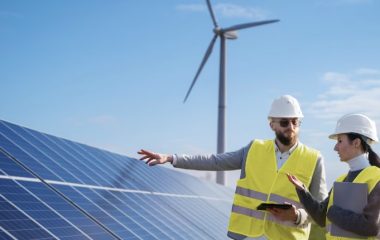A number of cross-border and internal power lines in the region, as well as the extension of Chaira pumped hydroelectricity storage are crucial for market connectivity and integration of renewable energy sources, European Network of Transmission System Operators for Electricity (Entso-E) pointed out in an updated draft of its grid development plan.
Expected renewable energy growth in the Continental South East (CSE) region and namely in Bulgaria, Greece and Romania, necessitates planning and putting in place of new energy infrastructure to up trans-border capacity and electricity market integration, the organization argued in its draft ten year grid development plan update which oversees energy trends by 2030, portal Publics.bg reported.
CSE region covers the Balkans and Italy. The regional group comprises transmission system operators (TSOs) of Bosnia and Herzegovina, Bulgaria, Croatia, Cyprus, Greece, Hungary, Macedonia, Montenegro, Romania, Serbia and Slovenia. According to Entso-E, Bulgaria will see tremendous growth of photovoltaic and wind power generation. While in 2012 the country had 1 GW of photovoltaic and 700 MW of wind, Entso-E forecasts 8 GW and 4 GW respectively by the end of the next decade. On the regional level, between 2012 and 2030 photovoltaic capacity will reach 41 GW (up from 5 GW), and wind – 22 GW (up from 6 GW), while hydro should rise to 31 GW (up from 22 GW).
Ambitious estimates
Entso-E however points out that it based its future estimations on „the most ambitious vision,” first expressed in the 2014 version of its 10-year plan and far beyond what the TSOs’ transmission development plans usually considered up to now and will „require important investments of national, regional and pan-European relevance on the network.“ Nevertheless Entso-E highlights a number of grid development projects which should help mitigate electricity transportation bottlenecks. A third interconnector between Bulgaria (Maritsa East 1) and Greece (Nea Santa) and a new double 400 kV interconnection line between Bulgaria and Serbia will have to address need to increase the transfer capacity and improve integration. Both projects are considered in the long run, with completion dates set at 2030 and beyond.
The so called Black Sea Corridor, which will comprise three power lines in Romania and one in Bulgaria (Dobrudzha – Burgas), is set for completion in 2021, as vital mid-term infrastructure which should allow for electricity from renewable sources to be transported towards consumption and storage centers in Central and Southeastern Europe. They come in the form of two pumped storage hydro power stations in Greece and Bulgaria, as well as a battery storage in South Italy, all of which should be ready by 2021. The Yadenitsa dam, part of the Belmeken-Sestrimo hydro cascade with its Chaira pumped hydroelectricity storage plant, is designated as a project of common interest (PCI) and is estimated to have the biggest storage capacity among the three – 5.2 GWh.
Proposals for overriding bottlenecks
The most loaded interconnection line is between Serbia and Bulgaria. Significantly loaded ones are mainly located between Serbia and Romania, Bulgaria and Macedonia, Bulgaria and Greece, as Bulgaria and Romania are significant exporters of electricity while Serbia, Macedonia and Greece are major importers, the report said. Serbia and Macedonia are importing in winter time, when specified overloads of lines appeared. Greece is a significant importer in summer months.
In order to answer the overloads occurring in analyzed scenario the representatives of CSE TSOs agreed on a list of new projects. Overload at the borders between Bulgaria and Serbia, Bulgaria and Macedonia, as well as Romania and Serbia will be solved with two new projects: double 400 kV overhead line Sofia West (Bulgaria) – Niš 2 (Serbia) and the doubling of the existing 400 kV Đerdap 1 (Serbia) – Porțile de Fier (Romania). Constraints on the border between Bulgaria and Greece, which is observed on the future 400 kV Maritsa East – Nea Santa will be solved by doubling that transmission line. Overload at the border between Romania and Hungary will be solved by building a new 400 kV line Debrecen – Oradea. Furthermore, market simulation results shown the need to increase the capacity on the borders between Serbia and Croatia as well as between Croatia and Bosnia and Herzegovina. New 400 kV Ernestinovo (Croatia) – Sombor 3 (Serbia) line would also resolve overloads on the 400 kV Sandorfalva (Hungary) – Subotica 3 (Serbia) and on the internal Hungarian 400 kV connector Paks – Sándorfalva. There is also a need to upgrade existing 220 kV lines between substations Đakovo (Croatia) and Tuzla/Gradačac (Bosnia) to 400kV lines.
Transmission hub for Serbia
Two internal projects were nominated in Serbia. The first project consists in upgrading the existing 220 kV voltage network in central Serbia to 400 kV. This project is directly related to increasing the cross-border capacity with Bulgaria, Montenegro and Bosnia and Herzegovina. The second project consists in closing the 400 kV ring around capital Belgrade. This project resolves overloads that were noticed on the overhead 400 kV line Pančevo 2 – Belgrade 20 in common planning studies. Besides, it allows the transit of electricity from Romania towards Croatia and Italy. Other overloads in internal networks of Romania, Greece and Slovenia could be resolved by congestion management measures, the report said.

















